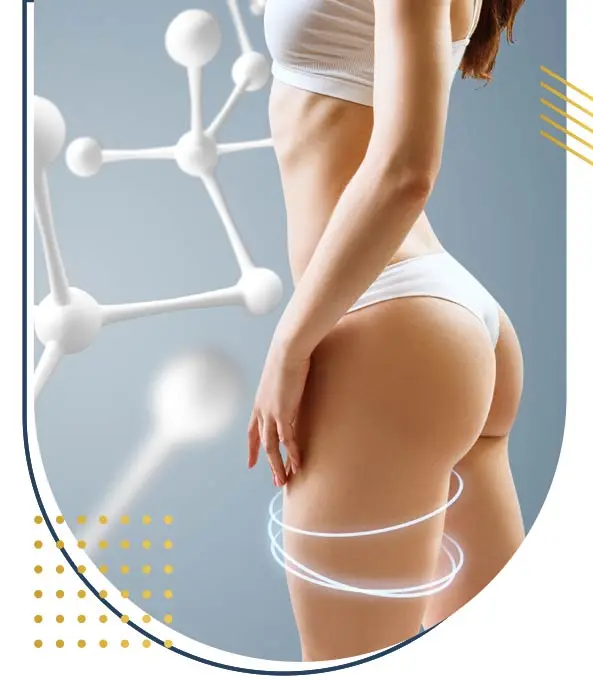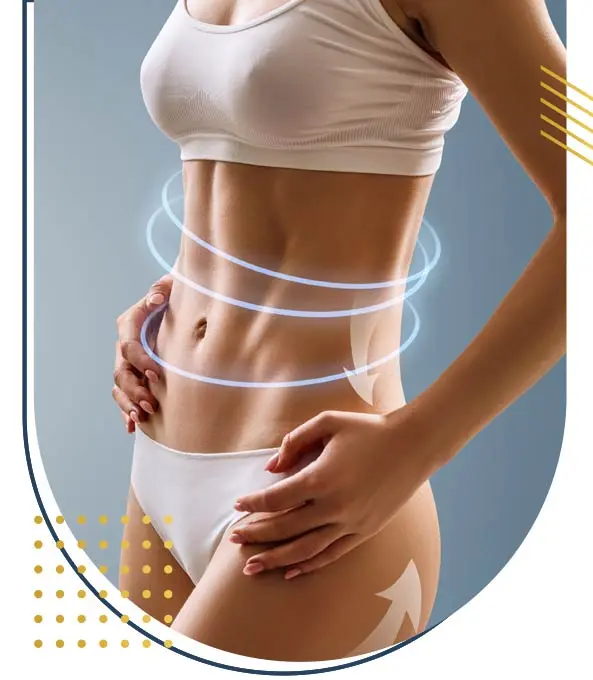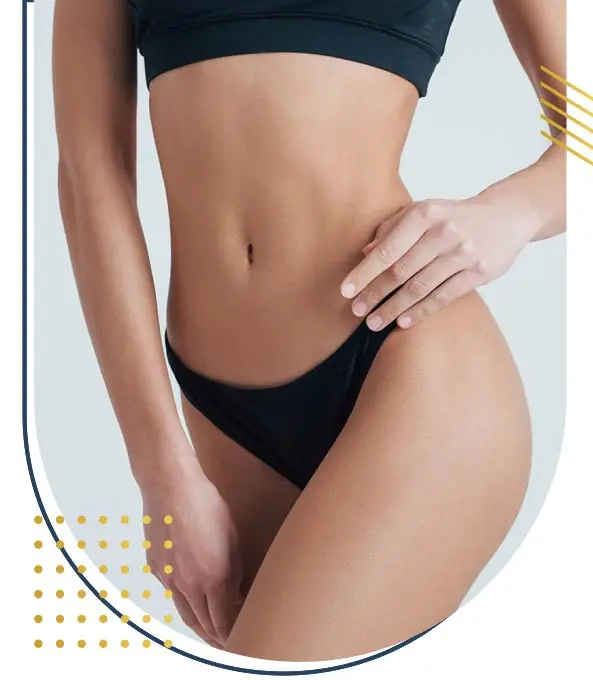
Liposuction realized in Egypt is a plastic intervention that consists of removing a patient's excess fat (that he could not get rid of through sport and diet) from different ares of the silhouette such as the belly, buttocks, hips, thighs…by suction through cannulas inserted under the skin.
This procedure is an effective solution to improve the contours of the silhouette and allow the patient to boost his self esteem while feeling more comfortable and in harmony with himself.
Liposuction price in Egypt
The price liposuction Egypt is affordable, so, ask for a free online quote to obtain liposuction cost Egypt or contact us by phone on the phone numbers you will find on our website to be in a direct contact with one of our counselors who will give you all the details of this plastic surgery.
What are the types of the Liposuction procedure ?
Traditional Liposuction :
Traditional liposuction, also known as suction-assisted lipoplasty (SAL), is the original method of fat removal that has been in practice for decades.
This procedure involves the use of a cannula, a thin tube, which is inserted through small incisions in the targeted area.
The cannula is then moved back and forth to break up and suction out fat cells. This technique requires the use of a tumescent solution, a mixture of saline solution, local anesthetic, and epinephrine, which is injected into the treatment area to minimize bleeding and discomfort. Traditional liposuction is suitable for various body areas, including the abdomen, thighs, buttocks, and arms.
It is often chosen for its effectiveness in removing larger volumes of fat compared to some newer techniques. However, it typically involves a longer recovery period and may result in more significant bruising and swelling.

Power-Assisted Liposuction (PAL) :
Power-assisted liposuction (PAL) is a refinement of traditional liposuction that utilizes a vibrating cannula to facilitate fat removal. The vibrating motion of the cannula helps to break up fat cells more efficiently, making them easier to suction out.
This technique reduces the physical effort required by the surgeon, allowing for more precise and controlled movements.
PAL is particularly beneficial in treating dense or fibrous areas of fat, such as those found in the male chest or upper back.
By using power assistance, surgeons can achieve smoother results with reduced trauma to the surrounding tissues. Patients undergoing PAL may experience less post-operative discomfort and a quicker recovery compared to traditional liposuction.
Ultrasound-Assisted Liposuction (UAL) :
Ultrasound-assisted liposuction (UAL) utilizes ultrasonic energy to liquefy fat cells before suctioning them out.
During the procedure, a specialized cannula emits ultrasound waves that target and disrupt fat cells, turning them into a liquid substance.
This liquefied fat is then removed using suction. UAL is particularly effective in treating areas with dense fat deposits or fibrous tissue, such as the upper abdomen, flanks, and back. The ultrasonic energy also stimulates collagen production, which can lead to skin tightening and improved contouring in the treated area.
While UAL offers the advantage of smoother results and reduced trauma to surrounding tissues, it may carry a slightly higher risk of complications such as skin burns or seromas (fluid collections).
Laser-Assisted Liposuction (LAL) :
Laser-assisted liposuction (LAL), also known as laser lipolysis or SmartLipo™, utilizes laser energy to target and liquefy fat cells before removal.
A thin fiber optic cannula is inserted through small incisions, delivering laser energy directly to the fat deposits. This energy heats and melts the fat cells, making them easier to suction out. Additionally, the heat produced by the laser stimulates collagen production, promoting skin tightening and smoother contouring.
LAL is often chosen for its ability to target small areas of fat with precision, such as the chin, neck, and arms. The procedure is minimally invasive and typically results in less bruising and swelling compared to traditional liposuction. However, it may not be suitable for large-volume fat removal.
Water-Assisted Liposuction (WAL) :
Water-assisted liposuction (WAL), also known as hydro-assisted liposuction, utilizes a pressurized stream of saline solution to dislodge and remove fat cells.
Unlike traditional liposuction, which relies solely on manual manipulation or energy-based methods, WAL involves the injection of tumescent fluid followed by the gentle application of a water jet to loosen fat deposits.
The emulsified fat is then suctioned out through a cannula, leaving surrounding tissues relatively undisturbed. WAL offers the advantage of reduced trauma, minimal bleeding, and quicker recovery times compared to other techniques. It is particularly well-suited for treating delicate areas such as the face, neck, and knees.
Additionally, the use of tumescent fluid helps to minimize discomfort during and after the procedure, making it a preferred option for many patients.
Radiofrequency-Assisted Liposuction (RFAL) :
Radiofrequency-assisted liposuction (RFAL), also known as BodyTite™ or AccuTite, combines liposuction with radiofrequency energy to simultaneously remove fat and tighten the skin. During the procedure, a specialized cannula delivers controlled radiofrequency energy to the targeted area, heating the underlying tissues and causing them to contract. This thermal effect stimulates collagen production, leading to skin tightening and improved contouring.
RFAL is particularly effective in treating areas with mild to moderate skin laxity, such as the abdomen, thighs, and arms. The procedure is minimally invasive and typically results in less bruising and swelling compared to traditional liposuction. RFAL can also be performed under local anesthesia, reducing the risks associated with general anesthesia.
VASER Liposuction :
VASER liposuction, short for Vibration Amplification of Sound Energy at Resonance, is a minimally invasive technique that utilizes ultrasound technology to selectively target and remove fat cells. Unlike traditional ultrasound-assisted liposuction, which relies on continuous ultrasonic energy, VASER liposuction uses pulsed ultrasound waves to disrupt fat cells while preserving surrounding tissues. This selective approach allows for smoother results and quicker recovery times.
VASER liposuction is highly customizable, allowing surgeons to sculpt and contour various body areas with precision.
It is particularly well-suited for treating areas with fibrous or dense fat deposits, such as the back, flanks, and male chest. Additionally, the ultrasound energy stimulates collagen production, promoting skin tightening and improved overall texture.
External Ultrasound-Assisted Liposuction (XUAL) :
External ultrasound-assisted liposuction (XUAL) is a variation of ultrasound-assisted liposuction (UAL) that utilizes external ultrasound energy to emulsify fat cells before suctioning them out. Unlike traditional UAL, which involves the insertion of a specialized cannula emitting ultrasound waves directly into the treatment area, XUAL employs an external ultrasound device applied to the skin surface.
The ultrasound energy penetrates the skin and targets the underlying fat deposits, causing them to liquefy. Once the fat is emulsified, it can be easily removed using standard liposuction techniques.
XUAL offers the advantage of reduced invasiveness and faster recovery times compared to traditional liposuction methods. It is particularly suitable for patients seeking mild to moderate fat reduction and improved body contouring without undergoing extensive surgery.
Who is the best candidate for liposuction ?
It is important to know that liposuction performed in Egypt is not a weight loss surgery, but it only allows to remove localized fat cells that are resistant to diet and sport.
It is for people who are in a good health, have firm and elastic skin and those who suffer from excess fat in different parts of their figure such as the thighs, belly, buttocks, arms…that affect them psychologically.
It is destinated for patients who do not present contraindications to this procedure and are able and determined to maintain a healthy lifestyle after liposuction Egypt.
Before the intervention
The consultation with the surgeon is very important as he will examine you, your silhouette (type of skin, excess fat…), evaluate your health and medical history so as to check whether you are suitable for this procedure or not.
You will also explain him your desires and expectations, informs him about the medications you are taking of if you suffer from diseases or allergies, ask him questions so that he will advice you and explain you all the liposuction process such as its benefits, recovery period…
The discontinuation of oral contraception may be requested.
A complete medical check up as well as blood analysis must be done before the operation.
Moreover, your surgeon will give you some instructions that are as follow :
- Avoid smoking before and after your liposuction.
- Stop taking aspirin 6 weeks before the intervention.
- You should not eat or drink 8 hours before the procedure.
Additional preparations.
Transportation and Assistance :
Arrange for transportation to and from the surgical facility on the day of your procedure, as well as for someone to assist you at home during the initial stages of recovery.
You may not be in a condition to drive or perform certain activities independently immediately after liposuction surgery, so having reliable transportation and support readily available is essential for your safety and comfort.
Plan for Recovery :
Plan ahead for your postoperative recovery by setting aside adequate time off work or other responsibilities.
Depending on the extent of your liposuction procedure and your individual healing process, you may need to take several days to a week off to rest and recuperate at home.
Arrange for assistance with childcare, household chores, and other tasks as needed during the recovery period to ensure a smooth and stress-free recuperation.
Compression Garments :
Purchase compression garments recommended by your surgeon to wear following liposuction surgery.
These specialized garments apply gentle pressure to the treated areas, helping to minimize swelling, promote blood circulation, and support the healing process.
Your surgeon will provide specific instructions regarding when and how long to wear compression garments based on your individual needs and the extent of your liposuction procedure.
Home Preparation :
Prepare your home environment for a comfortable and conducive recovery following liposuction surgery.
Stock up on essential supplies, such as loose-fitting clothing, prescription medications, over-the-counter pain relievers, healthy snacks, and entertainment options to keep you occupied during downtime.
Create a relaxing and supportive space where you can rest and recover without unnecessary stress or distractions.
Mental Preparation :
Take time to mentally prepare yourself for the surgical process and recovery period ahead. Educate yourself about what to expect before, during, and after liposuction surgery, including potential risks, benefits, and outcomes.
Maintain realistic expectations about the results of your procedure and understand that the final outcome may take several weeks to months to fully manifest. Seek support from loved ones, friends, or mental health professionals if you experience anxiety, apprehension, or emotional challenges related to your upcoming surgery.
How is it performed ?
Liposuction performed in Egypt is realized under general anaesthesia and lasts about 2 hours according to the case of each patient and the excess fat to be removed.
First of all, your surgeon will mark on your figure the areas to be treated by liposuction.
The plastic surgeon uses very fine cannulas (3 to 5 millimetres maximum) to suck out excess fat in order to reshape the figure. The incisions are tiny and hidden in the natural folds which allows optimal concealment of scars. The fat is aspirated while respecting the nerves and vessels through a regular set of tunnels.
Liposuction Egypt :aftercare and recovery
After your liposuction realized in Egypt, your surgeon will prescribe you painkillers to reduce the pain.
He will also prescribe the wearing of a shaping dressing or a compression garment adapted to your morphology in order to limit oedemas (postoperative swelling of the operated tissues) and postoperative bruising. This support will be worn for 4 weeks or more (depending on the amount of fat that has been removed as well as the quality of the skin, your surgeon will indicate you the period).
You will be able to resume your professional activities after a period of 2 weeks, it also depends on the type of your job.
You must avoid strenuous activities and carrying heavy loads.
Your surgeon may advise lymphatic drainage sessions for certain patients.
The sutures will be removed around the 10th day if they are not absorbable.
Sport must be stopped during up to 2 months after your liposuction and resumed with the consent of your surgeon who will indicate your the period.
Liposuction Egypt results
The results of your liposuction in Egypt are excellent and satisfactory, they can be appreciated after the intervention, but, they are final from the 2nd and 3rd postoperative month and will improve with time.
To maintain the results, you must opt for a healthy lifestyle and follow all the recommendations and advice of your surgeon such as eating healthy meals (fruits, vegetables…) and opting for a regular physical activity for example swimming or cycling two or three times a week and to get a minimum of exercise during the day, walk home from the office or take the stairs instead of the lift.
What are the risks of the Liposuction procedures ?
Infection :
Despite the use of sterile techniques, there is always a risk of infection following liposuction surgery. This risk can be minimized through proper preoperative skin preparation, antibiotic prophylaxis, and postoperative wound care.
Bleeding :
Liposuction involves the removal of fatty tissue, which may result in bleeding during and after the procedure. Excessive bleeding can lead to hematoma formation (collection of blood under the skin) and may require additional surgical intervention to address.
Hematoma :
Hematomas are collections of blood that can accumulate under the skin following liposuction. While small hematomas may resolve on their own, larger ones may require drainage to prevent complications such as infection or tissue damage.
Seroma :
Seromas are fluid collections that can develop under the skin after liposuction. These fluid pockets may cause swelling, discomfort, and delayed wound healing. Seromas may require aspiration or drainage to resolve fully.
Skin Irregularities :
Liposuction can sometimes result in uneven or irregular contours, leading to dimpling, waviness, or asymmetry in the treated area. This risk is higher in patients with poor skin elasticity or those who undergo aggressive fat removal.
Skin Necrosis :
In rare cases, liposuction can cause damage to the skin's blood supply, leading to tissue necrosis (death). Skin necrosis may manifest as areas of discoloration, blistering, or skin breakdown, requiring prompt medical attention to prevent complications.

Nerve Damage :
Liposuction can potentially damage nerves in the treated area, resulting in temporary or permanent numbness, tingling, or altered sensation. While nerve injuries are uncommon, they can occur, particularly in areas with dense nerve supply such as the abdomen or thighs.
Contour Deformities :
Aggressive or uneven fat removal during liposuction can lead to contour deformities such as overcorrection, undercorrection, or irregularities in the treated area. Revision surgery may be necessary to address these issues.
Fluid Imbalance :
Liposuction involves the infusion of tumescent fluid into the treatment area to facilitate fat removal. In rare cases, excessive fluid absorption or fluid overload can occur, leading to electrolyte imbalances, dehydration, or pulmonary edema.
Anesthesia Complications :
Liposuction is typically performed under either local anesthesia with sedation or general anesthesia. While complications related to anesthesia are rare, they can include allergic reactions, respiratory problems, or cardiovascular events.

